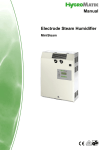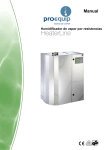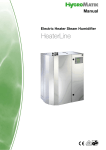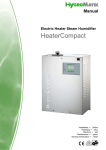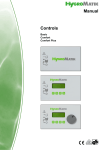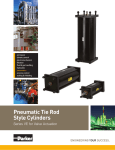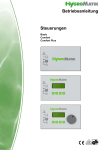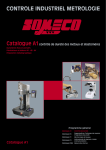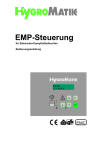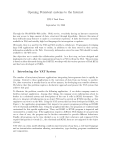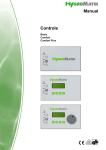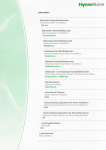Download Electrode Steam Humidifier Manual
Transcript
Manual Electrode Steam Humidifier A Word about Water Quality The mode of operation of all electrode steam humidifiers is based on the fact that water contains minerals and is therefore conductive. • "normal" tap water is ideal. • but what is "normal" tap water exactly? Users of HygroMatik units in the most diverse areas consider their tap water "normal." HygroMatik typically defines "normal" as feed water with a conductivity between 200 and 500 µS/ cm (microSiemens per centimeter) at 15° C. Some areas, however, are supplied with tap water whose quality is outside the parameters specified by HygroMatik. If the HygroMatik steam humidifier's control is not adjusted correctly in these areas, the unit cannot perform optimally. For example, the electrodes could wear out particularly quickly or the steam production could be too low. The operational parameters set by HygroMatik in the factory are intended for normal tap water. However, they can very easily be reprogrammed to fit the special requirements of a particular area. In addition, it is possible to install a plastic star in the cylinder in order to increase the life span of the electrodes or to provide a flushing mechanism to extend maintenance intervals. Because of this you should monitor your new unit during initial operation. Make sure that it has been properly installed and is operating to your satisfaction. Consult your HygroMatik specialists. We will test the quality of your water and advise you on installation and initial operation. Your HygroMatik steam humidifier will be carefully adapted to your particular application. Copyright HygroMatik Lufttechnischer Apparatebau GmbH CompactLine 0508 Information in this manual is subject to change or alteration without prior notice. Warning, Hazardous Voltage: All work to be performed by trained personnel only. All electrical installation and servicing of the electrical components of this unit to be performed by qualified electricians only. Disconnect power supply before installation and servicing! Page 2 1. Introduction ....................................................................................................................... 5 1.1 Directions for Use .............................................................................................................. 5 1.2 Typographic Distinctions ................................................................................................... 6 1.3 Documentation .................................................................................................................. 7 2. Safety Notes ....................................................................................................................... 8 2.1 Overview ........................................................................................................................... 8 2.2 Guidelines for Safe Operation ........................................................................................... 8 2.3 Disposal after Dismantling ................................................................................................. 9 3. Transport ............................................................................................................................ 10 3.1 Overview ........................................................................................................................... 10 3.2 Carton outer Size and Weight ........................................................................................... 10 3.3 Packing .............................................................................................................................. 11 3.4 Interim Storage .................................................................................................................. 11 3.5 Check for Complete and Correct Delivery of Goods ......................................................... 11 3.6 Included in the Delivery ..................................................................................................... 11 4. Operation and Installation ................................................................................................ 12 4.1 Mode of Operation ............................................................................................................. 12 4.2 Installation and Operation ................................................................................................. 12 5. Installation ......................................................................................................................... 15 5.1 Steam Humidifier Operating Environment ......................................................................... 15 5.1.1 Fitting measures ............................................................................................................. 16 5.1.2 Equipment Dimensions C6 - C58 ................................................................................... 17 5.2 Fan Unit (optional) ............................................................................................................. 18 5.2.1 Fan Unit Type VG ........................................................................................................... 18 5.3 Absorption Distance BN .................................................................................................... 19 5.3.1 Determining the Absorption Distance ............................................................................. 19 5.3.2 Absorption Distance Nomogram .................................................................................... 21 5.4 Steam Manifold ................................................................................................................. 22 5.4.1 Notes on Installation ....................................................................................................... 23 5.5 Steam Line ........................................................................................................................ 26 5.6 Cover Plate ........................................................................................................................ 27 5.7 Drill Pattern ........................................................................................................................ 28 5.7.1 Drill Pattern DN25 (not to scale) ..................................................................................... 28 5.7.2 Drill Pattern DN40 (not to scale) ..................................................................................... 29 5.8 Condensate Hose .............................................................................................................. 30 5.9 Types of Installation .......................................................................................................... 30 5.10 Steam Solenoid Valves ................................................................................................... 32 5.11 Unit Installation Check ..................................................................................................... 32 6. Water Installation .............................................................................................................. 33 6.1 Operation with Softened Water ......................................................................................... 33 6.2 Water Supply ..................................................................................................................... 34 6.3 Water discharge ................................................................................................................ 35 6.4 Water Installation Check ................................................................................................... 36 Page 3 7. Electrical Connection ........................................................................................................ 37 7.1 Electrical Installation .......................................................................................................... 37 7.2 Fan Unit ............................................................................................................................. 40 7.3 Safety Interlock .................................................................................................................. 41 7.4 Wiring Diagram .................................................................................................................. 41 7.5 Electrical Installation Checklist .......................................................................................... 41 8. Commissioning ................................................................................................................. 42 9. Maintenance ....................................................................................................................... 43 9.1 Maintenance Work ............................................................................................................ 43 9.2 Access Electrical Enclosure .............................................................................................. 44 9.3 Removing and Cleaning the Steam Cylinder .................................................................... 45 9.4 Electrode wear .................................................................................................................. 50 9.4.1 Original Electrode Lengths ............................................................................................. 51 9.4.2 Uneven Electrode Lengths ............................................................................................. 51 9.5 Replacing Electrodes ........................................................................................................ 51 9.6 Cleaning the Blow- Down Pump ........................................................................................ 53 9.7 Cleaning the Water Inlet Solenoid Valve ........................................................................... 54 9.8 Checking Cable Connections and Electrode Cables ......................................................... 54 9.9 Checking Operation ........................................................................................................... 55 9.10 Dismantling ...................................................................................................................... 55 10. EC-Declaration of Conformity ........................................................................................ 56 11. Spare Parts ...................................................................................................................... 57 12. Fax Form - Order for spare parts ................................................................................... 62 13. Technical Data ................................................................................................................. 63 14. Exploded View ................................................................................................................. 64 15. View of housing ............................................................................................................... 65 Page 4 1. Introduction Dear Customer, Thank you for choosing a steam humidifier. HygroMatik steam humidifiers represent the latest in humidification technology. They will impress you with their safety, ease of use and economical operation. In order to operate your HygroMatik steam humidifier safely, properly and efficiently, please read these operating instructions. Employ your steam humidifier only in sound condition and as directed. Consider potential hazards and safety issues and follow all the recommendations in these instructions. If you have additional questions, please contact us: Tel.: +49-(0)4193 / 895-0 (Main Number) Tel.: +49-(0)4193 / 895-293 (Technical Support Hotline) Fax: +49-(0)4193 / 895-33 e-mail: [email protected] For all technical questions or spare parts orders, please be prepared to provide unit type and serial number (see name plate on the unit). 1.1 Directions for Use The HygroMatik steam humidifier is intended for steam production. Proper usage also entails following HygroMatik's instructions for installation, dismantling, reassembly, initial operation and operation and maintenance, as well as disposal procedures. Only qualified, authorized personnel may operate or service the unit. Workers who transport or service the unit must have read and understood the relevant sections of the operating instructions, especially the section "Safety Notes." In addition, staff must receive safety training about potential hazards from the operator. Place a copy of the operating instructions at the location where the unit is operated.. Page 5 Use feed water with a conductivity between 50 and 1200 µS/cm only D1: Lower threshold C1: Range of reduced conductivity A: Normal tap water B: Range of heightened conductivity C2: Range of heigh conductivity D2: Upper threshold Warning: HygroMatik steam humidifiers emit steam with a temperature of 100° C. The steam may not be inhaled directly. The HygroMatik Steam Humidifier is not designed for outdoor fitting 1.2 Typographic Distinctions • preceded by a bullet: general specifications. » preceded by an arrow: Procedures for servicing or maintenance which should or must be performed in the indicated order. ; Installation step which must be checked off. italics Terms used with graphics or drawings.. Page 6 1.3 Documentation Retention Please retain these operating instructions in a secure, always accessible location. If the product is resold, turn the documentation over to the new operator. If the documentation is lost, please contact HygroMatik. Versions in Other Languages These operating instructions are available in several languages. If interested, please contact HygroMatik or your HygroMatik dealer. Page 7 2. 2.1 Safety Notes Overview These safety notes are required by law. They promote workplace safety and accident prevention. Warnings and Safety Symbols The safety symbols below identify sections containing warnings about hazards or potential dangers. Please familiarize yourself with these symbols. Warning: Failure to observe this warning may result in serious injury or death and/or damage to the unit. Danger, Hazardous Voltage: Hazardous electrical current! Failure to observe this warning may result in injury or even serious injury or death. Warning: Failure to follow these instructions may result in damage to the unit due to electrostatic discharge. The electronic components of the humidifier control are very sensitive to electrostatic discharges. In order to safeguard these components during installation and servicing, steps must be taken to protect against ESD. Reminder: Materials and consumables must be handled and/or disposed of as required by law. Note: Appears before explanations or cross-references which refer to other sections of the operating instructions. 2.2 Guidelines for Safe Operation Overview Obey all safety notes and warnings present on the unit. In case of a malfunction, switch off the unit immediately and prevent a restart. Repair malfunctions promptly. After any repair work, have qualified personnel check the safe operation of the unit. Use original spare parts only. Additional national safety regulations also fully apply to the operation of this unit. Accident Prevention Regulations Comply with the accident prevention regulation Accident Prevention Regulation Electrical Systems and Equipment to prevent injury to yourself and others. Page 8 Operation of the Unit Do not perform any work which compromises the safety of the unit. Regularly check that all safety and monitoring devices are functioning normally. Do not remove or disable safety devices. Installation, Dismantling, Maintenance and Repair of the Unit Disconnect unit components from power supply prior to maintenance or repair work. Attaching or installing additional components is permitted only with the written consent of the manufacturer. Electrical Work on the electrical system must be performed by qualified personnel. Disconnect unit components from power supply prior to work In case of a malfunction in the electrical power supply, switch off the unit immediately. Use only original fuses with the appropriate amperage rating. Regularly check the unit's electrical equipment. Promptly repair any damage, such as loose connections or burned wiring. After proper electrical installation or repair, test all safety mechanisms (such as grounding resistance). HygroMatik steam humidifiers are IP20-protected. Make sure that the unit is protected from drips in its installed location. Installing a humidifier in a room without water discharge requires safety devices to protect against water leakages. 2.3 Disposal after Dismantling Note: The operator is responsible for the disposal of unit components as required by law. Page 9 3. Transport 3.1 Overview Note: Proceed carefully when transporting the steam humidifier in order to prevent damage due to stress or careless loading and unloading. 3.2 Carton outer Size and Weight HyLine: Type* HY05- 08 HY13- 17 HY23 HY30 HY45 HY60 HY90- 116 Height [cm] 58 75 75 81 88 80 90 Width [cm] 56 63 63 67 76 104 117 Depth [cm] 32 37 37 41 48 41 48 Weight [kg] 16 24 25 33 46 54 77 CompactLine: Type* Height [cm] Width [cm] Depth [cm] C6 52 50 28 C10 58 51 31 C17 75 54 37 C22 75 54 37 C30 75 58 37 C45 81 63 41 C58 90 72 48 Weight [kg] 13 14 22 22 23 25 36 MiniSteam: Type* Height [cm] Width [cm] Depth [cm] * MS 5 59 48 28 MS 10 68 51 31 Weight[kg] 13 15 * Dimensions and weights may vary slightly. Page 10 3.3 Packing Note: Notice the symbols affixed to the packing box. 3.4 Interim Storage Store the unit in a dry place and protect from frost. 3.5 Check for Complete and Correct Delivery of Goods Upon receipt of the unit, confirm that: • the type and serial number on the name plate match those specified in the order and delivery documents and • the equipment is complete and all parts are in perfect condition Note: In case of damage during shipment or missing parts, immediately notify the carrier or supplier in writing. Time limits for filing freight claims with shipping companies are*: Shipping Companies Mail Rail Truck and Rail Carriers Parcel Service After Receipt of Goods no later than 24 hours no later than 7 days no later than 4 days immediately * Time limits for some services subject to change. 3.6 Included in the Delivery The delivery includes: • Unit of the selected HyLine type including selected control. • Water installation hose 0,6m, 3/4". • Mounting set with anchors and screws. For HyLine types HY45 to HY116, extra mounting bar. • Operating Instructions for the unit and the control. • Ordered accessories (steam manifold, steam hose, condensate hose, etc.). • Maintenance o-ring set for steam cylinder. Page 11 4. 4.1 Operation and Installation Mode of Operation The HygroMatik steam humidifier utilizes the conductivity normally present in tap water for steam production. Electrodes inside an enclosed steam cylinder are immersed directly into the tap water. They are connected to the alternating current. The conductivity of the water generates an electric current between the electrodes. In this way, the electric power supplied is converted directly into heat without energy loss. The amperage is a function of the available voltage, the immersed electrode surface area, the average distance between the electrodes and the water conductivity. The steam output of the humidifier is determined by electric power usage, which is regulated by increasing or decreasing the immersed surface area of the electrodes. Concurrently, a self-regulating control keeps conductivity within a specified range. The steam produced has a temperature of about 100°C with minimal excess pressure ("pressureless steam"). It is free of minerals and largely germ-free. Mineral deposits typically remain behind in the cylinder. 4.2 Installation and Operation When the controller specifies an increase in humidity, the main contactor is switched on and the electrodes (48) are supplied with power. The water inlet solenoid valve (25) feeds water into the steam cylinder (16+19). As soon as the electrodes are immersed, the current begins to flow. The water is now heated. When the pre-selected output is reached, the control turns off the solenoid valve and interrupts the water supply. After a short heating up period, the water between the electrodes begins to boil and vaporize. The vaporization lowers the water level in the steam cylinder, reducing the output provided. The inlet solenoid valve, equipped with a fine mesh filter, intermittently admits fresh water. Humidifier power usage is continuously monitored. With a cold start-up, the nominal current increases to 125% in order to achieve quick-start output parameters. This activates the electronic overflow limiter which causes a partial draining of the cylinder. This reduces the immersed surface area of the electrodes, lowering power usage. Page 12 Please also see Section „Exploded View“. Location 1 6 10 14 16 17 18 19 25 32 35 37 48 Designation adapter vent pipe max. water level sensor electrode water drain, discharge top part of steam cylinder o-ring cylinder flange cylinder flange and o-ring lower part of cylinder solenoid valve water inlet blow-down pump o-ring cylinder base electrodes Page 13 The concentration of dissolved salts increases over time, which can lead to a rise in the conductivity of the water. If this continues, conductivity may increase until a short circuit occurs. This could damage the unit, but in any case would significantly reduce the life span of the electrodes. For this reason, regular, periodic blow-downs of some of the concentrated water are very important. Following this procedure as recommended provides stable cylinder water conductivity as well as minimal water loss for the expected service life of the cylinder. Water blow-down is performed by a blow-down pump (32). The functioning of the blow-down pump is continuously monitored during operation. If the pump is damaged, the steam humidifier shuts down. With normal water quality, the blow-down loss rate is between 7% and 15% of the amount of steam produced. The steam cylinder requires complete drainage every 3-8 days, regardless of the water quality. Mineral deposits settle in the open area below the electrodes and are removed through periodic maintenance. The blow-down pump itself has wide openings and can flush out smaller pieces of mineral deposit. This extends the service life of the unit and reduces the required maintenance interval. During blow-downs, water flows from the pump into the drainage system. A sensor electrode (10) monitors the maximum water capacity of the cylinder. When the water level reaches the sensor electrode, the water supply is interrupted. This can occur when the water has low conductivity or when the electrodes are worn out. In the case of low water conductivity, however, this state usually lasts only a short time. The built-in control and the large area electrodes combine to produce a rapid rise in conductivity by increasing the concentration of the water. The steam cylinder consists of a top (16) and lower (19) part joined with a cylinder flange. The seal between the cylinder and cylinder base (37), as well as between the top and lower part of the cylinder, is maintained using an o-ring (35+17). Page 14 5. Installation Warning: Installation of this unit to be attempted only by qualified personnel. We accept no liability for damage due to faulty installation. Obey all safety notes and warnings present on the unit. During installation the unit must be disconnected from its power supply. Attaching or installing additional components is permitted only with the written consent of the manufacturer, or else the warranty is void. 5.1 Steam Humidifier Operating Environment Note: When selecting the installation site for the steam humidifier, note that: • Ambient temperature must be between 5° and 40° C. • Relative humidity must not exceed 80% RH. • The minimum clearances indicated in the diagram below must be observed; these are necessary to ensure adequate ventilation for the housing. • The steam humidifier should be installed as close as possible to the steam manifold. Optimal performance is guaranteed only with short lengths of steam and condensate hose. • Hoses must be laid at a consistent 5-10% incline to prevent sagging and kinking. • The rear panel of the steam humidifier heats up during operation (to a maximum of 60°C). Take care that the construction on which the unit is mounted is not made of temperature-sensitive material. • Place the steam humidifier so that the unit is easily accessible with sufficient space to perform maintenance. • The steam humidifier is not qualified for exterior applications. Page 15 5.1.1 Fitting measures Clearances Note: When choosing the site for the steam humidifier, consider the location of existing water installations (feed and drain lines). Page 16 5.1.2 Equipment Dimensions C6 - C58 a b c d e f g h i j k l m n o p q C6 C10 C17/ C22/ C30 438 479 653 393 399 472 187 216 283 351 369 435 394 436 609 34 34 38 133 119 214 43 43 62 33 35 39 102 119 152 104 100 136 144 173 233 57 68 89 26 18,5 C45 C58 707 519 327 482 650 30 250 60 50 175 158 256 111 42 790 606 392 564 740 38 302 60 52 195 201 330 336 183 217 Page 17 5.2 Fan Unit (optional) Note: The fan unit should be positioned to avoid drafts. In general, a minimum height of 2 m is sufficient. • Install the fan unit directly on a wall. Fan Unit Type for wall installation VG 08, 17, 30 5.2.1 Fan Unit Type VG • Install the fan unit over the steam humidifier. • When employing multiple fan units, do not exceed a maximum distance of 5 m from the steam humidifier. • Observe the clearances specified in the diagram below: Fan Unit Wall Installation Steam Side View Wall Installation Page 18 5.3 Absorption Distance BN The "absorption distance" (BN) is defined as the distance from the steam feed to where the steam is completely absorbed in the treated air. Inside the absorption distance, steam is visible as mist in the air stream. Condensation may collect on anything installed inside the absorption distance. Although steam outside the absorption distance (BN) is completely absorbed, it is not yet evenly diffused in the duct. If you plan to install any parts or devices inside the absorption distance, such as sensors or elbows, we recommend increasing the absorption distance using the formulae below. The absorption distances required for certain installed fittings are distinguished by separate symbols and calculated as a multiplier of the absorption distance BN. Absorption Distance BN for normal obstructions, such as sensors, ventilators, outlets Bc = (1,5...2) x BN for fine filters, heat registers Bs = (2,5...3) x BN for particle filters Bd = (2,5...3) x BN for humidity sensors, duct humidistats The absorption distance has no fixed value, but depends on many factors. These are depicted in the absorption distance nomogram below. 5.3.1 Determining the Absorption Distance To determine the absorption distance, the following parameters are required: • Air humidity before humidification x1 in g/kg. • Air temperature after humidification t2 in °C (with steam humidifiers the change in air temperature due to humidification may be disregarded t1 or t2). • Specific increase in humidity mined in the h,x diagram) • quantity of steam introduced m • air speed wL in m/s in air duct • Total length lD of the steam manifold installed in the air duct x in g/kg (can be detero D in kg/h. Page 19 Length ID of the usable steam manifold depends on the dimensions of the air duct. The length of the absorption distance can be reduced by using multiple steam manifolds (also see section on the steam manifold). Method: Graphically determine absorption distance BN using the absorption distance nomogram (also see Section „Absorption Distance Nomogramm“ on page 24). Enter the value of the parameters enumerated above into the respective quadrants. The resulting point of intersection indicates the value of the desired absorption distance BN. Notes: Air humidity before humidification x1: _______________________________[g/kg] Air temperature after humidification t2: _______________________________[°C] Specific increase in humidity x:_______________________________[g/kg] quantity of steam introduced m D :_______________________________[kg/h] o air speed t w : _______________________________[m/s] L Total length of the steam manifold lD: _______________________________[mm] Page 20 5.3.2 Absorption Distance Nomogram Source: Henne, Erich: Luftbefeuchtung (Air Humidification), 3rd Edition 1984 (Page 101), Oldenbourg Industrieverlag, Munich Page 21 5.4 Steam Manifold Note: Shown installation and position dimensions are based on experimental values. Special environmental conditions could require adjustments. Please note: • Install the steam manifold as close as possible to the steam humidifier in order to minimize steam loss through condensation. Note: For steambath generators Type HyLine/CompactLine: • Install the steam manifold safe from contact with people in order to prevent injuries or burns. • Do not install the steam manifold near a temperature sensor or inaccurate readings may result. The number and size of appropriate steam manifolds, as well the nominal width of their respective steam and condensate hoses, are found in the tables below. HyLine: Type Steam Manifold HY05-HY17 1x25 HY23-HY30 1x40 HY45-HY60 2x40 HY90-HY116 4x40 Steam Condensat hose Hose DN25 DN12 DN40 DN12 2xDN40 2xDN12 4xDN40 4xDN12 CompactLine: Type C6-C17 C30 C45** C58 Steam Manifold 1x25 1x40 2x40 2x40 Steam Hose DN25 DN40 DN40 2xDN40 Condensate Hose DN12 DN12 DN12 2xDN12 DemiLine: Type DemiLine6-12 DemiLine17-26 Steam Manifold 1x25 1x40 Steam Hose DN25 DN40 Condensate Hose DN12 DN12 Page 22 HeaterLine: Type HL 6-12 * HL 18-24 HL 30-45 ** Steam Manifold 1x25 1x40 2x40 Steam Hose DN25 DN40 1xDN40 Condensate Hose DN12 DN12 1xDN12 Lenght of Steam Manifold [mm]* l DN25 DN40 220 x x 400 x x 600 x x 900 x x 1200 x x 1450 x x * For units HL 6 - 12 HygroMatik deliver one adapter DN40 / 25. ** For units HL 30 - 45 HygroMatik deliver one t-connector for separating the steam on two steam manifold. *** Special lenght on request. Note: At lengths of 900mm or more, steam manifolds are shipped with an extra alternative mounting fixture (Nut, M8) on the closed end 5.4.1 Notes on Installation Placement of the steam manifold on the supply side of the air duct is preferred. • Maximum allowable pressure in the air duct is 1200 Pa • On the return side, the maximum allowable negative air pressure is 500 Pa With high-pressure air-conditioning systems, the unit's drain or supply hose must be lengthened depending on the overall pressure. When this is the case please consult HygroMatik. When installing the steam manifold, please note the following: • The air intake can be positioned on the right or the left. • Observe a minimum distance of 120 mm from the top of the air duct. • Depending on the design of the air duct, additional mounting of the steam manifold may be required. • Shown installation and position dimensions are based on experimental values. Special environmental conditions could require adjustments. Page 23 • Position the steam manifold to ensure uniform steam distribution in the air duct. Install the steam manifold horizontal with it ensure a clean steam out. • Air Duct low narrow, high square low, very wide • Note on Installation Different lengths in the air flow direction side by side Identical lengths one on top of the other. Staggered laterally if possible. Identical lengths, staggered vertically and laterally Facing each other. By tilting the steam manifold 30 - 45° towards the air flow direction, the minimum upper clearance can be reduced to 70 mm. Page 24 H1 [mm] DN25 DN40 30° 182 193 45° 168 179 H2 [mm] 225 230 • Horizontal installation of the steam lances is preferred. However, installation from below into the air duct is possible. • If installation conditions are exceptional, carefully evaluate the state of the air. Above all, assess the danger of condensation in the duct. • We note that the German Association of Engineers (VDI) Guideline 6022 specifies a water drain within the absorption distance inside the air duct. Page 25 5.5 Steam Line Note: When installing the steam hose, please pay attention to the following: • The steam hose diameter may not be smaller than the steam outlet of the HygroMatik steam humidifier (do not restrict the cross-section, otherwise back pressure will increase). • The steam hose must be without sags and kinks and be laid with a continuous slope of 5-10% (otherwise sags will be formed). • The steam hose should be as short as possible. In case of lengths of over 5 m the hose should be insulated to avoid excess condensation. • In the case that steam output is distributed on two steam manifolds the T-pieces for the steam and condensate hose should be installed near the manifolds. If the installation is carried out in this way only one steam hose is necessary for the main part, loss of condensate will be decreased. • Depending on how the hose is laid, hose clips should be set at intervals of approx. 500 mm. • Allow access to the steam hose, so that it can be inspected later. • In case of straight lengths of several meters, it is recommended to place the steam hose in temperature resistant plastic pipe (40 mm dia for hose DN25; 60 mm dia for hose DN40) or to use copper pipe. • Only genuine HygroMatik hoses are capable of withstanding the operating conditions. Allow for minimum bending radii: Steam hose DN 25: Rmin = 200 mm Steam hose DN 40: Rmin = 400 mm Page 26 5.6 Cover Plate HygroMatik flange plates may be used to neatly complete installation of the steam humidifier in the air duct. Two-piece flange plates are available for the DN25 and DN40 steam manifolds. flange plate DN25 E-2604260 flange plate DN40 E-2604410 Page 27 5.7 Drill Pattern 5.7.1 Drill Pattern DN25 (not to scale) Note: Due to variable print media the dimensions are not to scale. Page 28 5.7.2 Drill Pattern DN40 (not to scale) Note: Due to variable print media the dimensions are not to scale. Page 29 5.8 Condensate Hose Note: When installing the condensate hose, please pay attention to the following: Warning: To keep condensate from accumulating in the duct, make sure condensate can drain freely. If the steam manifold is positioned higher than 500 mm above the steam humidifier: » Remove the condensate plug (12) from the connection fitting on the cylinde. » Lay the condensate hose at an approximate incline of 5-10% to the steam cylinder connection fitting, to allow the condensate to drain freely. Note: It is recommended to form a loop of 200 mm diameter as a vapour trap provided there is enough space. Possible operating noises can be reduced in this manner. If the steam manifold is positioned lower than 500 mm above the steam humidifier: » The condensate must be drained separately. » To prevent steam loss, lay a loop at least 200 mm in diameter. » To ensure condensate drainage, place the loop (vapor trap) as far away as possible below the steam manifold connection. » The condensate connection on the steam cylinder must be closed with a sealing cap. » Place hose clamps at intervals of at least 500 mm, depending on how the hose is laid. 5.9 Types of Installation If the steam manifold is positioned higher than 500 mm above the steam humidifier: » Lay the steam hose at a height of at least 400 mm above unit and then connect to the steam manifold with a constant rise or fall. » Lay condensate hose with a slope to the steam cylinder. Page 30 » If enough space is available, lay a loop as a vapor trap. The steam manifold must be at least 500 mm from the loop. If the steam manifold is positioned lower than 500 mm above the steam humidifier: » Lay steam hose at a height of at least 400 mm above unit and then connect to the steam manifold with a constant fall. » Lay condensate hose with a loop of 200 mm diameter (vapour trap) to the drain. The distance between vapour trap and steam manifold should have at least 500mm. » Lay the loop of condensate hose 200 mm directly above the drain. Detail x Page 31 5.10 Steam Solenoid Valves When humidifying a number of loads, which are to be controlled separately, using a single steam humidifier, steam solenoid valves can be included in the steam hoses. Valve control has to provided by the customer. • Install the vertical risers with flow from bottom to top. • The best position is just above the steam humidifier. Installation of Steam Solenoid Valve 5.11 Unit Installation Check Attention: This unit may only be operated by qualified and properly trained personnel. Please check the installation using the following list: ; Does unit hang vertically? ; Are wall distances to the unit within the range ; Does steam hose have a slope of 5-10%? ; Is condensate hose installed with a loop of min. 200 mm? ; Is steam manifold positioned correctly? Are all bolts and clamps tightened? Page 32 6. Water Installation Warning: When installing the water installation, note the following: • Have all work performed by a professional. • Disconnect power supply before installation. • Obey local public utility regulations • Verify that necessary safety measures have been taken – in compliance with either German Technical and Scientific Association for Gas and Water (DVGW) guidelines (German Institute for Standardization [DIN] 1988) or local regulations – to eliminate backflow of polluted water into drinking water treatment facilities. This can mean laying the water supply line 300 mm above the unit (with automatic ventilator and extra check valve). Install a backflow preventer if necessary. • Use feed water without chemical additives and with a conductivity between 200 and 800 µS/cm only. Above conductivity levels of 800µS/cm to a maximum of 1200µS/cm and below conductivity levels of 200µS/cm to a minimum of 50µS/cm, special adjustments are required. In this case please contact HygroMatik. • The water supply temperature may not exceed 60° C. • Water installation pressure: 100 x 103 to 100 x 104 pascal ( 1 - 10 bar). • Blow-down water must be able to drain. 6.1 Operation with Softened Water Warning: Unless special measures are taken, feeding softened water into the HygroMatik steam humidifier is dangerous. It can cause • unacceptably high conductivity • the formation of salt bridges between the electrodes and the electrode leads on the inner surface of the top part of the steam cylinder • foaming in the steam cylinder Salt bridges cause electrical arcs. These are indicated by the presence of black grooves in the top part of the cylinder. The top part must be replaced to prevent further damage to the cylinder material, as well as short circuits which trip main circuit breakers. Foam comes into contact with the maximum water level sensor electrode and triggers a signal indicating the cylinder is filled to capacity, even though this is false and the nominal current has not yet been reached. Page 33 Note: Please contact HygroMatik if you wish to operate the unit with softened water. • If using a water softening system, we recommend diluting the softened water with normal tap water to produce an overall hardness between 4-8°dH. • When feed water contains softened water, the level of conductivity is typically higher at operating temperature. Install a HygroMatik "cylinder star" to extend the service life of the electrodes. 6.2 Water Supply » Install a shut-off valve (SV) in the supply line. » Install a water filter (WF) if water quality requires it. Note: Shut-off valve (SV) and water filter (WF) are not supplied with the unit » HygroMatik provides a water hose (56) with a cap nut at both ends which can be used for water installation. Install as follows: » Screw and tighten the cap nut with its inner seal ring around the water supply screw connection that protrudes from the base. Note: Tightening too much will destroy the fitting. The valve strainer (29) must be placed inside the solenoid valve. » Use a cap nut (internal thread ¾“) with inner seal for a customer-provided water installation. Page 34 6.3 Water discharge Warning: Water must drain freely! For water discharge, we recommend installation of a flexible water drain hose. Please note: • Do not bend, shorten or lengthen the drain hose. • Install discharge line and drain pipe made from temperature resistant material (to 95° C). Install water discharge as follows • Loosely insert a length of 1 1/4 " drain hose, approx. 150 - 300 mm, into a drain pipe with a minimum inner diameter of 40 mm and seal with a rubber gasket. • Fit water drain hose over the pump drain hose and fasten to the housing drain connection. A grounding clip is fixed on the inner surface of the housing drain connection. The end of the pump drain hose is pushed into this clip. During blow-down, the grounding clip is in direct contact with the water and shunts potential residual electric currents away from the housing. There is a 3mm-wide crack between the pump drain hose jacket and the inner surface of the housing drain connection. If water collects in the base plate, it will flow through this crack into the drainage system. Page 35 6.4 Water Installation Check Go down the following water installation checklist: ; Are all screws and clamps properly tightened? ; Is the water supply pipe flushed? ; Was the water installation correctly installed?(See Section 6.2) ; Can the blow-down water drain freely? ; Was the water discharge correctly installed? ; Is there no leakage from the water supply pipe and water discharge? Warning: Flush the water supply pipe before connecting to the solenoid valve, especially a newly installed pipe. This prevents premature damage. Page 36 7. Electrical Connection Danger, Hazardous Voltage: All work related to electrical installation to be performed by authorized personnel only (electricians or professionals with equivalent training). The customer is responsible for checking qualifications. Danger, Hazardous Voltage: Do not plug the steam humidifier into the power grid until after all installation work has been completed. Please obey all local regulations concerning electrical installation. Warning: The electronic components of the humidifier control are very sensitive to electrostatic discharges. In order to protect these components during any type of installation, steps must be taken to guard against damage from electrostatic discharge (ESD protection). Warning: For electrical installation, note the following: • Disconnect power supply before installation and protect against restart. • Verify the absence of electric current. • Make sure the unit is switched off before installing or removing the display plate or basic PCB. • Professionally lay electrical connector cable. • Install the electrical connections according to the wiring diagram. • For units with rated power over 33 kW, only a permanent connection to a permanent wire is allowable (German Association for Electrical, Electronic & Information Technologies [VDE] Standard 0700 Section 98). • Verify that all terminals have been tightened. 7.1 Electrical Installation » Fuses must have a contact gap of at least 3mm per pole. » Install a separate main connection for each steam cylinder, complete with main contactor, main switch, etc. » Connect potential equalization to the outer ground bolt. » Observe the German Association for Electrical, Electronic & Information Technologies [VDE] Standard 0100 when selecting a connection cross section. Install main power supplies as follows: » Page 37 HyLine: Type HY05 - HY45 HY60 - HY116 Main Power Supply 1 x 400V/3Phase/N 2 x 400V/3Phase/N CompactLine: Type CompactLine Main Power Supply 1 x 400V/3Phase/N MiniSteam: Type MS5 Main Power Supply 1 x 400V/3Phase/N MS10 MS5 1 x 230/1Phase/N DBE: Type DBE 2 DBE 6-45 Main Power Supply 1 x 230V/1Phase 1 x 400V/3Phase/N Other voltages are available on request. We recommend employing quick or medium blow main fuses (applicable only to the grid voltages above). See table below indicating maximum power usage for each circuit protection: HyLine: Type HY05 HY08 HY13 HY17 HY23 HY30 HY45 HY60 HY90 HY116 Power Usage 5,4 A 8,7 A 14,1 A 18,4 A 24,9 A 32,5 A 48,8 A 2 x 32,5 A 2 x 48,8 A 2 x 62,8 A Circuit Protection 3 x 6A 3 x 10A 3 x 16 A 3 x 20 A 3 x 35 A 3 x 35 A 3 x 63 A 6 x 35 A 6 x 63 A 6 x 63 A Page 38 CompactLine: Type C6 C10 C17 C22 C30 C45 C58 Power Usage 6,5 A 10,8 A 18,4 A 23,8 32,5 A 48,8 A 62,8 A Circuit Protection 3 x 10 A 3 x 16 A 3 x 20 A 3 x 35 A 3 x 35 A 3 x 63 A 3 x 63 A MiniSteam: Type MS5, 230V/1/N MS5, 400V/3/N MS10, 400V/3/N Power Usage 15,7 A 5,4 A 10,8 A Circuit Protection 1 x 16 A 3x6A 3 x 16 A Power Usage 6,5 A 6,5 A 10,8 A Circuit Protection 1 x 10 A 3 x 10 A 3 x 16 A DBE: Type DBE 2 DBE 6 DBE 10 Page 39 7.2 » Fan Unit Connect fan unit according to the wiring diagram. The fan unit operates in parallel with the humidifier. Note: Terminals 37 and 38 are only installed if the option „fan unit“ is ordered. Page 40 7.3 Safety Interlock Note: Install contact interlocks, i.e. max. hygrostat, vane relay, pressure controller, air interlock, in series between terminals 1 and 2. Warning: A max-hygrostat should be installed in the safety interlock. The max-hygrostat acts as a safety device in case the humidity sensor malfunctions. Warning: Contacts laid between terminals 1 and 2 must be potential free and rated for 230V switches. 7.4 Wiring Diagram Please remove the wiring diagram from the technical manual supplied with the control used with your humidifier. Every steam humidifier comes with one technical manual for the unit and one for the control. 7.5 Electrical Installation Checklist Perform electrical installation checks in compliance with customer site requirements and public power utility regulations: ; Is the power grid voltage compatible with the voltage on the name plate? ; Have all electrical connections been made according to the terminal connection diagram? ; Have all electrical cable and plug connections been properly tightened? ; Are all electrical socket connections secure? ; Is the unit grounded? After this check the unit can be switched on. Warning: The unit must be closed and locked. This guarantees that the cover is grounded. (only humidifier type HyLine and MiniSteam) Note: For initial operation, control, service, malfunctions, and circuit diagrams, consult the operation instructions for the HygroMatik-controls. Page 41 8. Commissioning Warning: This unit is only to be started by qualified personnel. Switching off steam humidifier Warning: Before starting up the unit, make sure you know how to switch it off. » Switch off unit by setting control switch to “0” » Close water supply stopcock valve. Switching on Steam Humidifier » Check that all electrical wire connections, including heater element wire connections, are tight and secure. » Check cylinder seating, and if necessary steam and condensate hose clamps. » Switch on main breaker. » Open water supply stopcock valve. Operating pressure 100 x 103 to 100 x 104 Pa (0.2 to 10 bar). » Switch on unit by setting control switch to “I”. » Set control of initial operation check to humidity demand. The following functions are operating: • The unit performs a self-test. If the control includes a display, the message “self-test“ is displayed. • When there is a demand for humidity, the water inlet solenoid valve opens and feeds water into the steam cylinder. • Initiation of steam production can take up to 20 minutes. Let all electrically-driven operations run to completion. As soon as the solenoid valve begins replenishing the water periodically, the steam humidifier operates at steady nominal output and the cold start sequence is complete. » Monitor the unit and let it operate for 15 to 30 minutes. If leaks appear, switch off the unit. » Repair leaks, and in doing so: Attention, Hazardous Voltage! Follow safety instructions for work on live components. Page 42 9. Maintenance The HygroMatik steam humidifier is easy to maintain. However, inadequate or improper maintenance can lead to operational malfunctions. Perform regular maintenance to give your unit a long life span. Warning: When performing maintenance work, please note: • The unit is only to be serviced by qualified, authorized personnel. • Observe safety notes. • Switch off the unit before maintenance and protect against restart. • After maintenance work, have qualified personnel check that the unit is operating safely. The steam humidifier's performance and maintenance intervals primarily depend on the water quality (carbonate hardness, conductivity) and the quantity of steam produced since the last maintenance. Abnormal water quality can shorten or lengthen maintenance intervals. Ongoing maintenance intervals can be estimated based on the amount and type of residue found in the steam cylinder. Indications that cylinder maintenance is required immediately include: Control Basic Comfort Comfort Plus Indicator maintenance message: red and green LED are blinking: Unit has switched itself off automatically. Maintenance message on the display (red and green LED are blinking). Unit has switched itself off automatically*. The maintenance message can also be sent by the open programmable potentialfree contact(only available for control type Comfort and Comfort Plus). See manual for control. 9.1 Maintenance Work Mineral deposits precipitate and crystallize very differently in different types of water, even when two types have the same conductivity and hardness levels (the various constituents in the water interact differently). Instructions on maintenance and cleaning intervals, or on electrode service life, are based entirely on empirical data. Page 43 Cycle Maintenance Work 4 Weeks after Visual inspection of electrical and initial operation mechanical connections (with normal Remove mineral deposits from steam cylwater quality) inder, water drain hose and blow-down pump Check electrodes for erosion Visual inspection of electrical mechanical connections and Semiannually (with normal water quality and Remove mineral deposits from steam cyl"normal" operainder, water drain hose and blow-down tion = 8h/day) pump und ggf. erneuern.Check electrodes for erosion In most cases, the conductivity levels given in Section "Directions for Use" of these instructions can be considered normal. Individual parameter setting of the control may be necessary. In extreme cases, water pretreatment may be necessary (softening by dilution to approx. 4 - 8 °dH; decarbonization/partial desalination to achieve target reductions in carbonate hardness). HygroMatik would be pleased to refer you to companies specializing in water treatment systems. 9.2 Access Electrical Enclosure » Remove cover from humidifier (B) and lift display plate (A) of guiding. » Turn display plate (please see sketch) and hang up display plate by using the „front guiding“. » The basic PCB (C) is now accessable. Danger, Hazardous Voltage: Make sure the unit is switched off before installing or removing the display plate. Page 44 9.3 Removing and Cleaning the Steam Cylinder Warning: Please follow the detailed instructions in these operating instructions! The unit is only to be serviced by qualified, authorized personnel. Note the warnings and safety notes in the operating instructions. Failure to observe warnings and safety notes may result in injury, serious injury or death, and/or damage to the unit. The steam cylinder may still be hot when you begin maintenance work. Handle carefully! Note: After a longer period of operation the steam cylinder could shrink a little. This doesn‘t matter but could lead to tightness discrepancies when only one half of the cylinder is being exchanged. Therefore we recommend not to change only one half of the cylinder but a complete cylinder. Page 45 Page 46 Warning: Check the inside of the top part of steam cylinder for crust build-up and possible salt bridges (black grooves between the electrode leads). If present, wash away completely . Note: If electrical arcs have burned deep grooves in the material, the top part of the cylinder must be replaced. Warning: Clean the sensor electrode until it is bright. Page 47 Note: When putting the cylinder back together, the joints and reinforcements of both sections must fit together snugly. Page 48 Warning: The plug must be pressed down onto the electrode as far as it will go. Note: Connect plugs to the correct electrodes. Note the color of the knurled nut. Note: Condensate connection must be showing in the front on the left. Page 49 Warning: The unit must be closed and locked. This guarantees that the cover is grounded. (Only with hymidifier type HyLine and MiniSteam) Switch on the unit and check for leaks after 15-30 minutes of operation. 9.4 Electrode wear Electrode wear depends on: • feed water composition and conductivity. • the quantity of steam produced. Page 50 Warning: At the latest, electrodes must be replaced if a maintenance message is displayed. The maintenance message appears after one hour of operation at maximum water level. The humidifier switches itself off. Also see Section "Maintenance." When the electrodes are less than 1/3 to 1/2 of their original length, replace them. 9.4.1 Original Electrode Lengths Original lengths of HygroMatik large area stainless-steel electrodes are: HyLine: Type HY05-HY08 HY13-HY60 HY90-HY116 Length [mm] 155 235 300 CompactLine: Type C6 C10 C17-45 C58 Length [mm] 125 155 235 300 MiniSteam: Type Length [mm] MS5 125 MS10 155 9.4.2 Uneven Electrode Lengths In most case, the longer electrode(s) will not be supplied with electricity for a time. Therefore they will not wear. The cause of the problem, such as a tripped circuit breaker, can be repaired. However, since the shorter electrode(s) have a greater specific load, the electrodes continue to wear unevenly. Note: Replace electrodes with significantly uneven wear. Check the power supply (breaker, voltage drop). Also see electronic operation, Section "Malfunctions." 9.5 Replacing Electrodes Page 51 » Remove and open cylinder, as described in Section 8.3 "Removing and Cleaning Steam Cylinder." » Loosen knurled nuts (5) and remove electrodes (48). » Install new electrodes and hand tighten the nuts. Use solvent-free, HygroMatik-quality o-rings (for flange, cylinder base and steam hose adapter). » Assemble steam cylinder and place it into cylinder » Connect plugs (4) directly to the electrodes (48) (with gray, red and black knurled nuts). It is not necessary to detach the knurled nuts! Warning: The plug must be pressed down onto the electrode as far as it will go. Note: Connect plugs to the correct electrodes. Pay attention to the color of the knurled nut. Page 52 » Attach plug (8) to the sensor electrode. (Knurled nut (9) - gray) » Switch breaker back on. » Switch on the unit and check for leaks after 15-30 minutes of operation. If leakage occurs, switch off power supply and follow safety instructions for work on live components. Note: In the following cases: • the electrodes must be frequently replaced, • black slime collects inside the cylinder, or • there is "lightning" in the cylinder, the conductivity of the water is too high or it isn't decanted often enough. In this case please contact HygroMatik. 9.6 Cleaning the Blow- Down Pump » Remove cylinder » Detach e-cable from the pump. » Detach adapter (30) from the pump. » Loosen screws (44) and remove the pump from the base. » Open the pump (bayonet lock). » Remove residues from the drain hoses and pump (if neccessary replace o-ring (33) or housing (34) if these components are no longer in excellent condition). » Reassemble the pump. » Moisten o-ring (31) and insert in the side connection of the base. » Push pump into the base and mount tightly with screws (44). » Moisten o-ring (31) and insert in adapter (30). » Fit adapter (30) over the side connection of the pump. » Connect e-cable to the pump. » Install cylinder. » Switch on the unit and check for leaks during operation. If leakage occurs, switch off power supply and follow safety instructions for work on live components. Page 53 9.7 Cleaning the Water Inlet Solenoid Valve Removal » Shut off water supply and loosen water installation hose connection. » Remove cylinder please also see chapter „Removing and Cleaning Steam Cylinder“ » Loosen connecting hose (21) from the base. » Detach e-cable from the solenoid valve. » Loosen solenoid valve mounting screws (28). » Remove solenoid valve from the borehole. » Remove fine mesh filter (29) from the solenoid valve, clean and replace if needed. Installation » Insert fine mesh filter (29). » Place solenoid valve with seal in the borehole of the unit housing. » Attach solenoid valve tightly with screws (28). » Screw on water installation hose. » Connect e-cable to the solenoid valve. » Attach connecting hose (21) to the base. » Install cylinder. » Turn on the tap. » Switch on the unit and check for leaks during operation. If leakage occurs, switch off power supply and follow safety instructions for work on live components. 9.8 » Checking Cable Connections and Electrode Cables Make sure that no cable and plug connections are loose. Warning: Plugs must be pressed down onto electrodes as far as they will go. Loose cable connections cause excessive contact resistance and overheating of contact surfaces. » Check electrode plug isolation, replace plugs as needed. Warning: Replace electrode plugs after removing and reinstalling them several times. Page 54 9.9 Checking Operation Start up the unit and operate for a few minutes at maximum output if possible. » Check safety devices. » Check hose connections for possible leaks. 9.10 Dismantling After you stop using the steam humidifier, dismantle (demolish or scrap) it by following the installation procedures in reverse order. Warning: Dismantling of the unit is only to be attempted by qualified personnel. Electrical dismantling is only to be attempted by trained professionals. Note the information provided in Section 2 "Safety Notes," especially the guidelines for disposal. Page 55 10. EC-Declaration of Conformity Page 56 11. * C6 C10 C17 C22 C30 C45 C58 Spare Parts Article No. Description Steam generation 1 B-3216067 1 B-3204031 1 B-2204101 1 B-2204151 1 B-2204111 1 B-2204105 1 16 16 16 16 16 16 1 19 1 1 1 1 1 1 1 19 B-3216044 Lower part of steam cylinder compl. with strainer CY4 * B-3216007 Lower part of steam cylinder compl. with strainer CY8 * 1 19 1 1 B-2206046 Lower part of steam cylinder compl. with strainer CY17* 1 19 19 17 17 17 17 17 35 35 48 48 48 B-2206071 Lower part of steam cylinder compl. with strainer CY30* 1 1 1 1 1 1 1 1 1 1 1 1 1 1 1 1 1 1 1 1 48 48 10 10 10 B-2204109 E-3216043 E-3226005 E-2206068 E-2206082 E-2206069 E-2207001 Steam cylinder CY4 compl. with electrodes and hand nuts * Steam cylinder CY8 compl. with electrodes and hand nuts * Steam cylinder CY17 compl. with electrodes and hand nuts * Steam cylinder CY17 DN40 compl. with 3 electrodes and hand nuts * Steam cylinder CY17 DN40 compl. with 6 electrodes and hand nuts * Steam cylinder CY30 compl. with electrodes and hand nuts * Steam cylinder CY45 compl. with electrodes and hand nuts * Top part of steam cylinder CY4 DN20/9, empty Top part of steam cylinder CY8 DN25/12, empty Top part of steam cylinder CY17 DN25/12, empty Top part of steam cylinder CY17 DN40/12, empty Top part of steam cylinder CY30 DN40/12, empty Top part of steam cylinder CY45 DN40/12, empty B-2206227 1 1 B-2204083 1 1 1 4 1 1 4 3 3 B-2207002 E-3216046 E-3216010 E-2206050 E-2206051 E-2207011 E-3216011 E-2204022 B-3216061 B-3204019 B-2204081 1 1 1 1 1 1 1 1 1 B-2204085 B-3204037 B-3204027 B-2204075 Lower part of steam cylinder compl. with strainer CY45* O-ring seal for cylinder flange, transparent cylinder O-ring seal for cylinder flange, transparent cylinder O-ring seal for cylinder flange, transparent cylinder O-ring seal for cylinder flange, transparent cylinder O-ring seal for cylinder flange, transparent cylinder O-ring seal for cylinder base O-ring seal for cylinder base Electrodes compl. with hand nuts, set=3pc. for CY4 Electrodes compl. with hand nuts, set=3pc. for CY8 Electrodes compl. with hand nuts, set=3pc. for CY17 Electrodes compl. with hand nuts, set=3pc. for CY17, CY30 DN40 Electrodes compl. with hand nuts, set=6pc. for CY17, CY30 DN40 Electrodes compl. with hand nuts, set=6pc. for CY45 DN40 Sensor electrode compl. with hand nut Sensor electrode compl. with hand nut Sensor electrode compl. with hand nut E-3216025 Plug-in contact with insulating hose for sensor electrode Plug-in contact with insulating hose for steam generating E-3216024 electrodes Page 57 * C6 C10 C17 C22 C30 C45 C58 4 4 18 37 37 1 1 1 1 1 1 12 1 12 1 1 1 1 3 3 6 6 18 18 18 24 6 36 1 1 1 1 1 1 1 1 1 1 1 1 E-2206059 1 1 1 2 1 1 1 1 1 1 1 12 12 2 2 3 3 3 3 1 1 1 1 1 1 1 1 1 1 1 1 1 1 1 1 2 2 1 1 1 2 1 1 Article No. 1 E-2207016 E-3216022 E-3220000 E-2206086 B-3216023 E-3221000 E-3221002 E-2209000 E-2209004 E-2209006 E-2209008 B-3216077 B-3216079 B-2207029 B-2207043 B-2207031 B-2207033 B-2207035 E-3216021 E-2204035 E-3221004 E-2209002 E-2209010 E-3216011 E-3221006 E-2204022 Description Plug-in contact with insulating hose for steam generating electrodes Plug-in contact with insulating hose for steam generating electrodes Cylinder flange clamp Cylinder base DN 20/25i/15/12 Cylinder base DN 40/25i/15/12 Mounting set for cylinder base Adapter DN20/25 for steam hose DN25 Adapter for steam hose DN25 Adapter for steam hose DN25 Adapter for steam hose DN40 Adapter for steam hose DN40 Adapter for steam hose DN40 maintenance kit for cylinder** maintenance kit for cylinder** maintenance kit for cylinder** maintenance kit for cylinder** maintenance kit for cylinder** maintenance kit for cylinder** maintenance kit for cylinder** Condensate cap DN9 Condensate cap DN12 Clip for adapter DN25 Clip for adapter DN40 O-ring for adapter DN40 O-ring for adapter DN20/25 O-ring for adapter DN25 O-ring for adapter DN40 Water feed 1 1 1 1 1 E-2604002 Connecting hose, solenoid valve - cylinder base, per m Solenoid valve, servo controlled, straight type, 0,2 B-2304081 10bar, 1,2 l/min Solenoid valve, servo controlled, straight type, 0,2 B-2304083 10bar, 2,5 l/min Solenoid valve, servo controlled, straight type, 0,2 B-2304085 10bar, 3,0 l/min 1 1 1 1 1 E-2304016 fine filter for inlet solenoid valve 21 0,60 0,60 0,60 0,60 0,60 0,60 1,90 25 1 25 1 25 29 1 1 56 1 1 1 1 1 1 1 1 1 1 1 1 1 1 38 0,40 0,40 0,60 0,60 0,60 0,60 0,80 20 1 1 1 1 1 1 1 B-2304031 E-2305002 E-2604004 E-2604062 Hose for water connection, 3/4" cap nuts on both sides Sealing for hose for water connection Hose for manual water drain Stopper, conical, lock for hose E-2604010 Water drain 1 1 1 1 1 1 1 B-3401015 B-3401017 B-3401019 B-3401013 B-3401021 Pump-drain-hose-system (Pos. 6, 14, 15, 30, 31) Pump-drain-hose-system (Pos. 6, 14, 15, 30, 31) Pump-drain-hose-system (Pos. 6, 14, 15, 30, 31) Pump-drain-hose-system (Pos. 6, 14, 15, 30, 31) Pump-drain-hose-system (Pos. 6, 14, 15, 30, 31) Page 58 * 31 31 33 32 57 6 C6 C10 C17 C22 C30 C45 C58 1 1 1 1 1 1 1 1 1 1 1 1 1 1 1 1 1 1 1 1 1 1 1 1 1 1 1 1 1 1 1 1 1 1 1 1 1 1 1 1 1 1 1 1 1 1 1 1 1 Article No. E-3220005 E-3220005 E-2404024 B-2404027 B-2424014 E-2420423 E-2425004 Description O-ring for pump - cylinder base O-ring for pump - adapter O-ring for drain pump (cover-motor) Drain pump without mounting set Mounting set for drain pump Drain hose 1 1/4" Elbow with vent pipe Electronic universal 1 1 1 4 1 1 1 1 4 1 1 1 1 1 1 1 1 1 B-3526019 1 B-2524201 1 4 B-2524249 1 4 B-2524205 1 4 B-2524209 1 1 E-2501005 E-2501006 E-2505007 E-0505009 E-2505206 1 B-2524213 B-2525051 1 1 1 1 1 B-2525055 Main contactor 16A, 230V Main contactor 24A, 230V Main contactor 40A, 230V Main contactor 63A, 230V Control fuse 1,6A, 5x20 mm Connecting cables for electrodes with plug-in contact, set=3pc Connecting cables for electrodes with plug-in contact, set=3pc Connecting cables for electrodes with plug-in contact, set=3pc Connecting cables for electrodes with plug-in contact, set=6pc Connecting cables for electrodes with plug-in contact, set=6pc Connecting cables for electrodes with plug-in contact, set=6pc Connecting cable for sensor electrode with plug-in contact,630mm Connecting cable for sensor electrode with plug-in contact, 1150mm Steam generation with electrical supply higher than 500V 1 1 1 1 1 1 1 1 1 1 2,5 3 5 6 8 6 8 6 E-2206054 E-2206056 E-2207014 B-2208007 B-2208013 B-2208009 B-2208011 E-9000110 E-2206059 E-9000132 E-2207016 O-ring CY17, silicone, for cylinder flange O-ring CY30, silicone, for cylinderflange O-ring CY45, silicone, for cylinderflange Cylinder star CY17/3 Cylinder star CY17/6 Cylinder star CY 30 Cylinder star CY 45 Cable H07V-K2,5 [m] Plug-in conatct for electrode 35A Cable H07V-K6,0 [m] Plug-in conatct for electrode 63A Control, electrical supply higher than 500V 1 1 1 1 1 1 1 1 1 1 1 1 1 1 1 1 1 1 1 1 1 1 1 1 E-2504158 E-2504168 E-2504160 E-2504166 E-2507024 E-2507022 E-2507018 E-2590102 Transformer 690V/230V, 25VA Transformer 480V-500V/230V Transformer 600V/230V Transformer 660V-690V/230V, 130VA Main contactor 60A, 230V/690V Main contactor 40A, 230V/690V Main contactor 25A, 230V/690V Line safety switch, 1 A Page 59 * C6 C10 C17 C22 C30 C45 C58 Article No. Description Control, electrical supply between 416V and 480V 1 1 1 1 1 1 1 1 1 1 1 1 1 1 1 1 E-2507024 E-2507022 E-2507018 E-2504157 E-2504168 Main contactor 60A, 230V/690V Main contactor 40A, 230V/690V Main contactor 25A, 230V/690V Transformer 208V-460V/230V Transformer 480V/230V Control, electrical supply below 230V 1 1 1 1 1 1 E-2504092 E-0505009 E-2505007 E-2501006 B-2524209 Main contactor 100 A, 230V Main contactor 63A, 230V Main contactor 40A, 230V Main contactor 24A, 230V Cable for electrode 35A/6mm² Basic Control 51 1 1 1 1 1 1 1 1 1 1 1 1 1 1 1 1 1 1 1 1 1 B-2526201 Basic Mainboard E-2502412 Control switch, double pole B-2120901 Mounting plate (Basic) Comfort Control 51 1 1 1 1 1 1 1 1 1 1 1 1 1 1 1 1 1 1 1 1 1 1 1 1 1 1 1 1 B-2526201 E-2502412 B-2120903 B-2526401 Basic Mainboard Control switch, double pole Mounting plate (Comfort) Display (Comfort) 1 1 1 1 1 1 1 1 1 1 1 1 1 1 1 1 1 1 1 1 1 1 1 1 1 1 1 1 B-2526201 E-2502412 B-2120905 B-2526403 Basic Mainboard Control switch, double pole Mounting plate (Comfort Plus) Display (Comfort Plus) 1 1 1 1 1 1 x x x x x x x 1 1 1 1 1 1 x x x x x x x 1 1 1 1 1 1 x x x x x x x 1 1 1 1 1 1 x x x x x x x 1 1 1 1 1 1 x x x x x x x 1 1 1 1 1 1 x x x x x x x 1 1 1 1 1 1 x x x x x x x B-2526211 E-2502412 B-2120903 B-2120905 B-2526401 B-2526403 E-0605228 B-2505207 E-0605232 E-2505206 E-3516020 E-2504039 E-2504154 DS-Basic Mainboard (PCB) Control switch, douple-pole Mounting plate (Comfort) Mounting plate (Comfort Plus) Display (Comfort) Display (Comfort Plus) Temperature sensor for steam bath control version V Holder for temperature sensor incl. mounting set Temperature Sensor ATF 2 for surface mounting Fuse for light, fan, essence injector 1.6A, 5x20mm Fuse for essence injection 2.5A, 2x20mm Fuse for transformer (E-2504154) 5A, 5x20mm Transformer 230/24V/130VA Comfort Plus Control 51 DS-Control 51 Page 60 * C6 C10 C17 C22 C30 C45 C58 Article No. Description Essence Injection x x x x x x x x x x x x x x x x x x x x x x x x x x x x x x x x x x x x x x x x x x x x x x x x B-2604091 B-2604083 E-2604072 E-2604074 E-2604076 E-2604070 B-2604067 B-2604069 pump, peristaltic DSP9111; 230V/50Hz; 3l/h pump, peristaltic DSP9111; 24V/50Hz; 3l/h hose for peristaltic pump DSP9431 hose for peristaltic pump DSP9111 hose connector for silicon hoses, 6mm hose, silicon, for essence; 6x1,5 T-piece for essence injection (DN25) T-piece for essence injection (DN40) Accessories x x x x x x ÷ x x x x x x x x x x x x x x x x x x x x x x x x x x x x x x x 1 1 x x x x x x x x x x 1 x 1 1 ÷ x x 1 x x 1 1 1 1 1 x x x x x x x x x x E-2604012 E-2604013 E-2604002 E-2404004 E-2604016 E-2304015 Steam hose DN25, per m Steam hose DN40, per m Condensate hose DN12, per m Steam hose clamp DN25 Steam hose clamp DN40 Condensate hose clamp Steam solenoid valve 0-0,4bar, compl. for steam hose DN B-2604026 25 Steam solenoid valve 0-0.4bar, compl. for steam hose B-2604040 DN40 Connectors for steam distribution T-piece DN25, stainless E-2604042 steel Connectors for steam distribution T-piece DN40, stainless steel Connectors for condensate T-piece DN12 Cylinder star Cylinder star Cylinder star Cylinder star Cylinder star Super flush complete Super flush complete Water connection hose, flexible, 0.6 m 3/4", with B-2304031 connector B-3320406 Filling cup complete E-2604023 E-2604021 B-2208005 B-2208007 B-2208013 B-2208009 B-2208011 B-2304063 B-2304065 If you order any spare parts, please specify type and serial number of the unit. * see Exploded View ** If the Super Flush System is installed, consider to order also a new nozzle (B-2304079), please. *** Maintenance kit contains: Electrodes without hand nuts, O-ring for adapter, O-ring seal for cylinder base, O-ring seal for cylinder flange, Cylinder flange clamps Page 61 12. Fax Form - Order for spare parts Fax Form Please copy, fill in and fax to Lise-Meitner-Str. 3 24558 Henstedt-Ulzburg Tel. +4904193/895-0 Fax.No. +49(0)4193/895-33 Order of spare parts unit type *______________ serial no.* ___________________ commission: ______________ order no.: __________________ quantity article article no. date of delivery ____________forwarder _____________ shipment by ___________ delivery address (if different from invoice address) company stamp (delivery adress) __________________________ __________________________ __________________________ __________________________ date/signature * Order can only be processed if unit type and unit serial no. are filled in. Page 62 13. Technical Data Technical Data Steam Humidifiers CompactLine C6-C58 Type C6 C10 C17 C22 C30 C45 C58 Steam Output [kg/h] 6,0 10,0 17,0 22 30,0 45,0 58,0 Electrical Supply* 400V/3/N 50-60 Hz Electrical Power [kW] 4,5 7,5 12,8 16,5 22,5 33,8 43,5 Current [A] 6,5 10,8 18,4 23,8 32,5 48,8 62,8 Fuse [A]**** 3x10 3x16 3x20 3x35 3x35 3x63 3x63 Control Type Basic, Comfort, Comfort Plus Control Voltage 230V Steam Hose Connection [mm] 1x25 1x25 1x25 1x40 1x40 1x40** 2x40 Condensate Hose Connection[mm] 1x12 1x12 1x12 1x12 1x12 1x12*** 2x12 Empty Weight [kg] 10 12 19 19 20 22 31 Operational Weight [kg] 13 18 37 37 38 49 77 Dimensions Height [mm] 438 480 652 652 652 706 789 Width [mm] 370 406 472 472 472 519 608 Depth [mm] 187 216 282 282 282 326 391 Water Supply 100 x 103 til 100 x 104 Pascal, for ¾" external thread Fan Unit, wallmounted Air Circulation of Fan Unit [m³/h] VG08 VG17 VG17 160 185 185 VG30 2 x VG30 2 x VG30 350 2 x 350 2 x 350 **** Times 1.3 power input after Full Blow Down. If expulsion fuses are used close to their specific limit we recommend to choose expulsion fuses with a higher range. *** The delivery includes T-pieces to condensate return of two manifolds. ** The delivery includes required T-pieces for connection of two manifolds. * Other voltages on request. Page 63 14. Exploded View Page 64 15. View of housing Page 65 12/2004 Lise-Meitner-Str.3 • D-24558 Henstedt-Ulzburg Phone +49(0)4193/ 895-0 • Fax -33 eMail [email protected] • www.hygromatik.com A member of the Group


































































